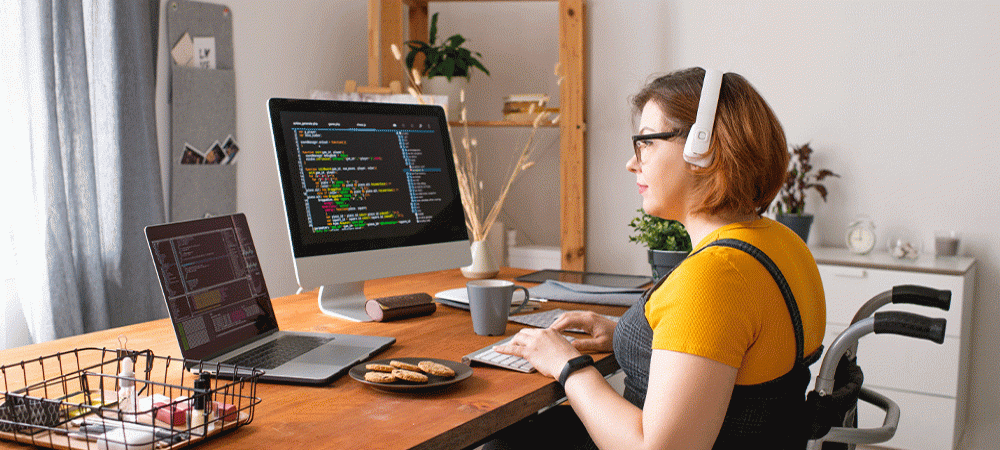Hybrid working is here to stay and COVID-19 has forced leaders to rethink the way they viewed remote working. Myles Leach, MD, NFON UK, talks about how hybrid working can benefit SMEs and the technology which needs to be in place to promote collaboration.
No one predicted at the beginning of the pandemic that 18 months later we would still be dealing with the fallout. Unprecedented consequences and change have impacted businesses, cultures and communities worldwide, and we’re still dealing with the result. In the UK alone, some reports anticipate the cost of COVID to SMEs will be upwards of £126.6 billion.
Out of this significant period in our world history, we have the opportunity for meaningful positive change within the SME business approach to be realised. COVID restrictions forced businesses to adopt new flexible homeworking approaches, with many being fearful of the outcome, but new research from NFON shows that SMEs have risen to the challenge. Hybrid working is becoming the new reality that has the scope to democratise the world of work and open the door for new technologies to support small businesses and make strides into recoupling losses and making the SME community across industry richer and stronger moving forward.
At the start of lockdown, the concern was that remote working could impact teamwork (51%), followed by not having a supportive IT set-up to successfully work remotely (32%) and a lack of trust that staff would work as hard from home (17%). But surprisingly, the reality has been much more positive than initially expected. Now, according to NFON’s Looking to the Future Report, 17% of small businesses expect to be completely remote in the future. A significant shift when before the pandemic, less than 50% of business owners encouraged any sort of remote working and 17% of survey respondents even admitted it was due to lack of trust in their staff to work as hard at home as they would in the office.
Small businesses have been introduced to the benefits of flexible working, with 33% of small business owners claiming to be ‘pleasantly surprised by the success of remote working’. Employees have stepped up, and perceptions have been significantly altered, with 25% of SMEs feeling that their team worked harder remotely than they did in an office setting. As a result, more and more businesses are moving towards offering a hybrid approach. This idea of a hybrid approach is about flexibility predominately. Most people view it as allowing individual employees the ability to work a few days from the office. A few days remotely each week is a set-up that 77% of UK employees said would be the best way forward post-lockdown. But ultimately, it’s about finding what would work best for your business that respects the needs of your talent with the business goals and objectives. For some companies, that’s about different teams working remotely vs others in the office or even about alternative weeks being office-based.
Whatever the chosen pattern, providing a hybrid flexible working approach has a measurable impact. NFON’s report found the top-listed benefits of remote working for SMEs, including:
• Reduced company expenses
• Less absence and sickness
• Positive environmental impact
• Increased staff wellbeing
The ability for flexible working has the opportunity to change the dynamics of your SME organisation. Hiring when you’re not dictated by location can offer huge opportunities for diversity and your bottom line. McKinsey’s report Delivering through Diversity reaffirms the global relevance of the link between diversity and company financial outperformance.
But to ensure that you can achieve all these benefits, you need the right technology. Organisations need to invest in reliable and secure systems that extend enterprise-level communications to the entire team, no matter where they are or what device they use. Suboptimal communications infrastructure will only compound the difficulties that remote teams face. Inconsistent connectivity, including outages and downtime, is a constant challenge. SMEs need to invest in reliable and secure systems that enable access to the entire team, no matter where they are or what device they use. No matter where they are working, all employees need a working environment where communications are flexible, interconnected and ubiquitous.
The right technology also helps to combat the negative side of remote working, such as feelings of loneliness, isolation and disconnection from the wider team. Making sure that you use technology and healthy management approaches to limit the potential impact is critical. It starts with management and teams changing beliefs around work being a place. There can’t be an underlying notion that power is held centrally and priority decisions only happen in the office by those who are physically in attendance. A cultural change ensures that all stakeholders and team members, when needed or required, are included, and technology is used to support this process. Success starts with building trust with employees, celebrating success and supporting processes with the right tools and technology, all focused on building a positive team and organisation identity.
The future will continue to evolve, and remote working software and collaborative tools will continue to be a critical part of the technology required. But as SMEs continue to develop their hybrid approaches and looking to the future, AI will be the next primary pursuit for businesses looking to transform their technological capabilities. Forty-four percent of teams believe their workers are ready for AI technologies, and 48% of UK small businesses already have or have plans to deploy AI technology.
SMEs worldwide took a significant hit during the pandemic. Still, new models and opportunities have emerged out of the disruption, forcing SMEs to provide flexible working which has provided the catalyst for change, enabling many to see the benefits and scope of their ability to democratise the world of work.
Click below to share this article

